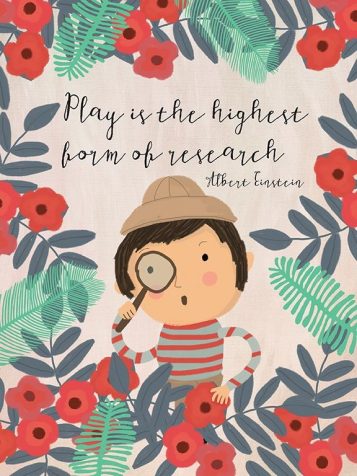Let the play begin……
Play is, in no sense, a simple thing; nor is it explained or interpreted with reference to
one or two criteria only. Play, in fact, is a very complex thing, as complex as human
beings themselves.
http://www.marclandry.ca/Marcs_Sensory_Oasis/Play!_files/The%20Scarfe%20Papers%202.pdf

Contemporary theories and research informed by the Reggio Emilia approach recognise and value the environment as a ‘third teacher’. Behind educators and families, physical spaces hold the potential to influence what and how children learn.
The idea that play is to ‘engage in activity for enjoyment and recreation rather than a serious and practical purpose’
https://en.oxforddictionaries.com/definition/play has been challenged by academics long before the recent advances in the theories of early years education pedagogy. Over 60 years ago, Neville Scarfe, Dean of the Faculty of Education at the University of British Columbia (1956 – 1974) established the Child Study Centre and Department of Young Children within the Faculty of Education, and in 1976 received an award from the Canadian Association for Young Children for his advocacy regarding the needs of quality education in early childhood. After his retirement in 1974, he began a period of intense work towards raising public awareness of the
value of play in early childhood. In his papers on
Understanding Children’s Play and
Play is Education, he wrote; ‘It will be the purpose of this paper to demonstrate that play is vital to childhood and that the spirit of play is an essential ingredient in mature adulthood. It is also hoped to show that play is the most complete educational process of the mind and is nature’s ingenious device for ensuring that each individual achieves knowledge and wisdom’.
Getting the environment right for play using continuous provision
A classroom is merely the bricks and mortar that contain the environment to support learning within. The environment plays a vital role in supporting and extending children’s development and learning. ‘Enabling’ environments (as defined within the EYFS statutory framework 2017) encourage young children to play because they feel relaxed, comfortable and ‘at home’ in them. When children feel emotionally safe and secure they can explore and find out about the place they are in and the things they can see, touch, manoeuvre or manipulate.
http://www.earlyyearsmatters.co.uk/our-services/school-and-nursery-improvement-partner/enabling-environments/
Contemporary theories and research informed by the Reggio Emilia approach recognise and value the environment as a ‘third teacher’. Behind educators and families, physical spaces hold the potential to influence what and how children learn.
http://files.acecqa.gov.au/files/QualityInformationSheets/QualityArea3/TheEnvironmentAsTheThirdTeacher.pdf
Within the environment, you will see tables and chairs, furniture, interactive whiteboards / TVs, displays, books, stationery, games, resources, toys and other paraphernalia. Look a little closer and you will see that there is structure to the various areas provided. Look closer still and you will notice that each area has purpose – it is there for a reason. This is continuous provision; a selection of resources that have been placed in areas by practitioners that continue the provision for learning in the absence of an adult. It:
- Links to assessment
- Is levelled around the ability of the children in that area
- Enhances learning with open ended resources to encourage investigation, exploration, and thinking
- Holds resources linked to children’s interests that will encourage engagement
Adapted from
https://abcdoes.com/abc-does-a-blog/2014/03/09/continuous-provision-planning/
Still think it is just play?
Continuous provision enables practitioners to take children on a journey and the environment is key to supporting children on this journey. To help further children’s development it is important for children to be able to return to explorations daily and to explore new ideas. Children need to be given time to thoroughly explore their learning experiences and practitioners acknowledge that it is fundamental that children are given opportunities to build on what they already know or what they have already tried. Giving children time is precious as it enables them to fully explore their ideas and concepts, thereby supporting steps taken along their journey.
Adapted from:
http://www.earlyyearscareers.com/eyc/latest-news/what-is-continuous-provision/
Next time you are in the classroom with your child, consider the environment around them. Ask yourself the question: What is the purpose of the continuous provision here? And then look closer and open your mind to the endless possibilities that are presented, considering the knowledge and skills that can be developed in each area. If you’re unsure, ask the teacher – I am certain that they can take you on a journey too. Wherever it leads, enjoy it; it will support the development of ideas on how you can provide a more enabling environment outside of the classroom for your child.
Shoes news!


We are asking for the support of all parents in ensuring that Hiba pupils wear plain black leather shoes with their uniform. These are the pupils’ outdoor shoes and it is important that they comply with the Hiba dress code (please refer to the Parents Handbook 2018-19). Indoor shoes should be a comfortable sports shoe that is easy to take on and off (no crocs please).
Message from Lydia Lim, Bursar (Service and Facilities)
Please note that the uniform shop will be opened this Saturday from 9am to 11am in Hiba school but will close on Tuesday 11
th September. The out-of-stock items occurred during the uniform week have finally arrived as promised. Parents whose child(ren) did not have the opportunity to purchase the full set of core uniform are strongly encouraged to purchase them on Saturday. We ask that ALL pupils are in full, seasonal uniform by Monday 10
th September.





